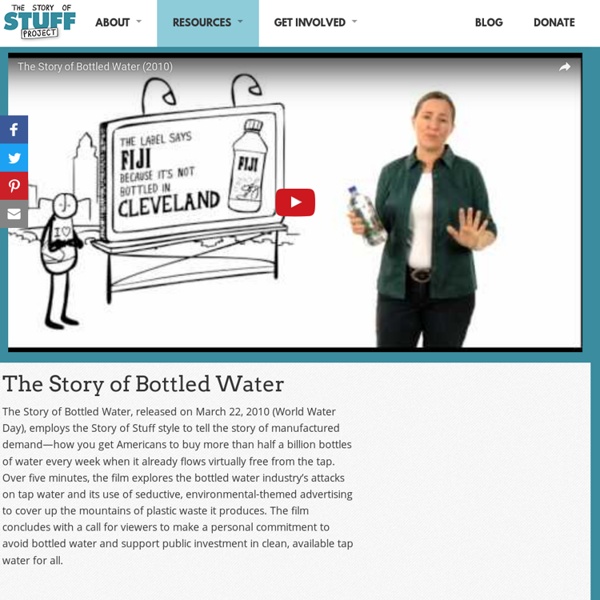The Story of Bottled Water

http://storyofstuff.org/movies/story-of-bottled-water/
Related: Pollution and climate change
• Watching
• Environment - Plastic
Why is Plastic Pollution a Problem in Our Oceans?
A sea turtle spots a plastic bag floating among the waves. To him, it looks like a jellyfish, its general shape and consistency swaying and catching the light in just the right way. He swims toward it and ingests the bag in one gulp, satisfying his hunger, and then goes on his away.
Shakespeare Solos: watch the first six films
Adrian Lester, Hamlet ‘To be or not to be’ Adrian Lester performs Hamlet’s soliloquy from act III, scene 1, in which the prince reflects on mortality and considers taking his own life.
The world agrees there's a plastic waste crisis—can it agree on a solution?
This article was created in partnership with the National Geographic Society. It didn’t take long after the recent United Nations environmental assembly in Kenya ended for environmentalists to sharply rebuke the United States for allegedly derailing global ambitions to prevent plastic debris from flowing into the oceans. “The tyranny of the minority,” their statement declared as environmentalists denounced the Americans for what they said was slowing progress on marine plastics by diluting a resolution calling for phasing out single-use plastic by 2025 and blocking an effort to craft a legally binding treaty on plastic debris. Yet that unsparing critique doesn’t fully reflect the negotiations that played out in a small roof-top conference room on the UN’s campus in Kenya’s capital city of Nairobi. What happened is perhaps best viewed not as tyrannical but as isolationist, more akin to the U.S. withdrawal from the Paris climate agreement. International treaties?
This Magical Desalinating Water Bottle Will Make The Ocean Drinkable
This bottle that separates drinking water from ocean water doesn't exist yet--except in the renderings you see here. But it would be nice if it did. It could be a useful addition to a boat's safety equipment, ensuring the shipwrecked are able stay alive without resorting to their own urine. The bottle was designed by a team from Yonsei University in South Korea, who recently entered it to the 2013 IDEA awards. The idea is simple: You pump a plunger at the top, pressurizing ocean water until it's pushed through a membrane at the bottom of one chamber.
The Story of Microfibers - The Story of Stuff Project
Most of us wear synthetic fabrics like polyester every day. Our dress shirts, yoga pants, fleeces, and even underwear are all increasingly made of synthetic materials — plastic, in fact. But these synthetic fabrics, from which 60% of all clothing on earth is made, have a big hidden problem: when they’re washed, they release tiny plastic bits — called microfibers — that flow down our drains, through water treatment plants, and out into our rivers, lakes and oceans by the billions. Go deeper:
Yoga - with dogs
It started in the US, when a growing band of health-conscious dog owners wanted a way of combining their favourite exercise with spending quality time with their pets. Now 'Doga' - yoga with dogs - is growing in popularity in the UK, mainly thanks to the efforts of Swiss-born yoga teacher Mahny Djahanguiri. She runs classes in London for people and their pets, and while the dogs do not really get a yoga workout themselves, they certainly play a part in some of the poses.
How to make paper straws
Did you know that plastic straws are one of the top items found during beach cleanups? And that they can be extremely harmful to our planet’s magnificent marine life? It’s time to take action!
Water Bottle Lights
I recently learned of a simple idea that is being used to bring light to many homes and businesses in third world countries during the daytime that would otherwise do without. Some because they have no access to electricity or others because it costs so much that they would rather not use electricity except when absolutely necessary. This innovation is known as water bottle lights or solar bottle lights. They use no electricity. Instead they act as mini skylights or solar tubes. Empty plastic soda bottles are usually the main material used to make the lights (although in one case I saw glass bottles have been used as well).
Related:



